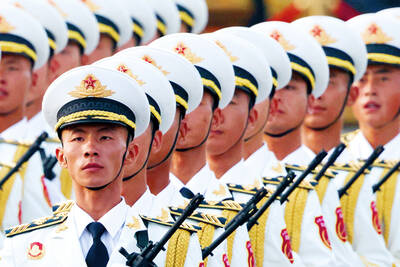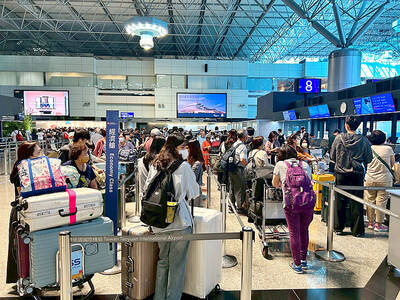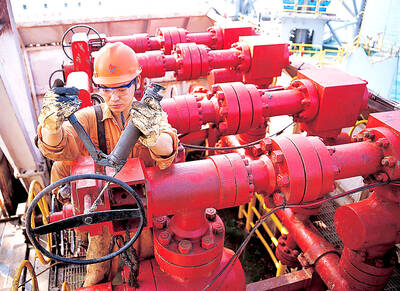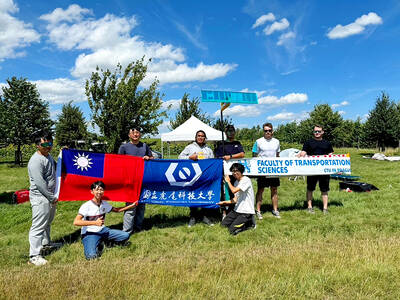The Consumers’ Foundation yesterday raised questions about a government decision to add another Electronic Toll Collection (ETC) lane at the Taishan (泰山) toll station on the Sun Yat-sen Freeway (National Freeway No. 1) despite the relatively small number of car owners who have installed the ETC on-board units.
At the beginning of 2008, 530,000 automobiles were equipped with the on-board units, which was about 8 percent of the market.
LOW ETC USE
As of January, 940,000 automobiles had the units installed, which is still only 14 percent of the market, the foundation said.
The watchdog group said that as a result of having a total of three ETC lanes in each direction of the Sun Yat-sen Freeway, non-ETC tollbooths would each on average need to collect tolls from more than 34,000 vehicles each day, which is equal to three times as many as the ETC tollbooths.
Despite the low rate of ETC useage among car owners, the National Freeway Bureau’s recent decision to set up a third ETC tollbooth in each direction of the Sun Yat-sen Freeway was disproportional, Consumers’ Foundation secretary-general Hwang Yu-sheng (黃鈺生) said.
The foundation also cited data that showed that during peak traffic hours, 5,795 vehicles without ETC units pass through the tollbooths each hour. This means that the five non-ETC lanes must each collect tolls from 1,159 vehicles per hour.
TRAFFIC JAMS
Taking into consideration that it takes an average of 3.4 seconds to collect a toll fee from each vehicle, it would take more than an hour for the vehicles to pass through the booths, causing heavy traffic congestion during peak hours, the foundation said.
The foundation said the heavy traffic caused for non-ETC motorists was the government’s way of unreasonably forcing drivers to install the ETC units in order to avoid spending long periods of time waiting to pass through the tollbooths. It urged officials to reconsider its toll plan.

The Chinese military has built landing bridge ships designed to expand its amphibious options for a potential assault on Taiwan, but their combat effectiveness is limited due to their high vulnerability, a defense expert said in an analysis published on Monday. Shen Ming-shih (沈明室), a research fellow at the Institute for National Defense and Security Research, said that the deployment of such vessels as part of the Chinese People’s Liberation Army (PLA) Navy’s East Sea Fleet signals a strong focus on Taiwan. However, the ships are highly vulnerable to precision strikes, which means they could be destroyed before they achieve their intended

About 4.2 million tourist arrivals were recorded in the first half of this year, a 10 percent increase from the same period last year, the Tourism Administration said yesterday. The growth continues to be consistent, with the fourth quarter of this year expected to be the peak in Taiwan, the agency said, adding that it plans to promote Taiwan overseas via partnerships and major events. From January to June, 9.14 million international departures were recorded from Taiwan, an 11 percent increase from the same period last year, with 3.3 million headed for Japan, 1.52 million for China and 832,962 to South Korea,

SOVEREIGNTY: The rigs show that Beijing ‘rejects Taiwan’s jurisdiction’ by building in areas where Taipei demands permission to build or alter installations Chinese oil rigs have been sighted just 26 nautical miles (42km), from Taiwan’s exclusive economic zone (EEZ) near Pratas Island (Dongsha Island, 東沙島), posing a threat to Taiwan’s sovereignty if left unchallenged, a brief published by the Jamestown Foundation on Tuesday said. Pratas Island, 444km from Kaohsiung, is northeast of the South China Sea and houses a Taiwanese garrison. The brief, titled “Rigging the Game: PRC Oil Structures Encroach on Taiwan’s Pratas Island” — referring to the People’s Republic of China — analyzed photographs and said that Beijing’s tools to pressure Taiwan now include oil rigs. “Oil rigs now constitute part of Beijing’s

The Taiwan Experience Education Program (TEEP) has funded short-term internships in Taiwan for more than 4,500 young people from more than 40 countries since 2015, with the goal of attracting and retaining international talent, the Ministry of Education said yesterday. Fifty-five colleges launched 514 projects this year, including in fields such as semiconductors, artificial intelligence, medicine and biotechnology, green energy, and sustainability, it said. The program provides research and practical internships in Taiwan for two to six months, and offers cultural exchange and networking opportunities, the ministry said. For example, National Formosa University’s Embedded System and Autopilot Laboratory developed two solar-powered drones in